| Skinny White Runway Models
The Fashion eZine - Fashion Models
Skin game on runways
PARIS–Skinny models are still dominating the runways of Europe, despite a furor in the media. But with all this attention on who is wearing the clothes, rather than on the clothes themselves, another troubling matter has come into focus: the lack of ethnic diversity on the runways. With 86 shows on the Milan schedule and each show with an average cast of 25 models, the odds are there would be more than a handful of blacks, Asians and other visible minorities. But in the few shows that did have ethnically diverse models on the catwalk, the non-white faces were ridiculously easy to count – perhaps one black and rarely more than two Asians. Things are not much better in Paris, though there are a few designers, such as Vivienne Westwood and Issey Miyake, who have a better track record when it comes to diversity. "It's never going to be easy for black girls," says Toronto-based Honorine Uwera, who appeared in the Westwood and Miyake shows this week. "I never understood why they would only use one or two black girls because really if you are going to use any at all why not cast more?" Some of the reasons she has heard for not being cast is that she is too dark or too skinny. But most times no reason is given.
On her many Milan go-sees, some designers told the Los Angeles-based model she did not have the look they wanted or she did not fit the clothes. "It could be a case of supply and demand," says Michael Giannini, creative director of d'Management Group, one of the top model agencies in Milan. "In the eyes of some designers they are showing the clothes on models that their market can relate to." What, then, to make of the African-American singer Eve and British-African actress Thandie Newton who sat front row at the Fendi show? Giannini feels designers tend to cast more black models in their spring shows, where the fabrics are lighter and the colours more complementary to their skin tones. More puzzling, perhaps, is the lack of Asian models on the runways, considering how rapidly luxury brands are setting up shop in emerging markets such as Asia. At some shows in Milan, Asian buyers and media filled several rows. Vogue launched in China last year and an Indian edition comes out this fall in Mumbai. Why are the runways not reflecting that? Giannini says that while there might be many Asians models on the circuit, designers seem to stick to two of the top ones: Hye Park and Du Juan.
"They are very android, less recognizable and have a very uniform look," notes Susie Sheffman, fashion director of Toronto's Fashion magazine. "None of the girls stand out now." After the personality-driven supermodel era, where the models – Linda, Naomi, Cindy – were household names, designers today are focused on not letting the faces overshadow the clothes. Giannini agrees, having been told that some of the ethnic models on his roster were too strong-looking or stood out too much in the line-up. "But I'm hoping this, too, will pass," he says. He points to positive evidence of the few Italian designers who support ethnic models, citing Gianfranco Ferre and Roberto Cavalli. Ferre's giant billboard ad campaigns around Milan feature a black model and he also used the black singer, Skin, to model in last week's show. Last year, Miu Miu used Asian models in its ads. French-African Kinee Diouf, in Milan for her first time this season, did make the cut for nine shows, albeit not the influential Gucci or Prada.
"When you go to Tokyo, the models in these ads are not Asian. They are most likely blond hair and blue eyes. There has to be change on both sides – not just from designers but from a consumer standpoint." Uwera, a Rwandan refugee who fled to Canada seven years ago with her sister after their parents were killed, isn't letting the race hurdle get her down. "I'm still going to castings. If they like me or not, that's not something I can control. But I'm trying just like everyone else. And that's all I can do."
Fashion world asks: How thin is too thin? NEW YORK -- Hip, young and thin as ever. As New York Fashion Week opened Friday with a phalanx of waiflike models strutting down the runway, all looked familiar under the big white tent in Bryant Park, where American designers will unveil their fall collections. A push for change is coming from outside the tent. It is getting harder for the fashion industry to ignore the growing chorus of displeasure from young women, psychologists, parents and spiritual leaders over the messages super-skinny fashion stars send, especially to young girls.
Among fashion's powerful, the question of why models must be so thin, and whether the industry sets an impossible and potentially dangerous standard of beauty, is still at the level of a debate. And there are outspoken dissenters. Top designer Karl Lagerfeld told Women's Wear Daily last week that efforts to regulate models amount to "politically correct fascism." It was business as usual at Friday afternoon's BCBG Max Azria show in New York, where 19 models, hair unbrushed, expressions blank, walked down the white runway in a dreamlike state toward scores of camera lenses waiting to blast their images around the world. Tall and bony, collar bones and spinal columns protruding, the overall image was stunning and unrealistic--romantic, earthy, nymphlike dresses cascading on stark forms. "Women don't normally look like that and it's very hard on young girls who think that's how they should look," said Vanessa Trump, wife of Donald Trump Jr., who sat in the front row at the BCBG Max Azria show dressed in jeans and a white cotton blouse.
|
|
 Some officials take action
Some officials take action
The issue of how thin is too thin has taken on urgency after Brazilian model Ana Carolina Reston, 21, died in November from complications due to anorexia nervosa. She was 5-foot-8 and 88 pounds. Officials in Spain and Italy have gone so far as to regulate who can appear in runway shows. And now Spain's department store chains, at the behest of the health ministry, will eschew skinny mannequins for more realistic versions. In the U.S. last month, the council of fashion designers marked another first, issuing recommendations aimed at protecting women, and very young girls in particular, from becoming thin to the point of bad health. They included common-sense steps such as developing workshops on the nature of eating disorders, avoiding hiring runway models under age 16 and providing "healthy snacks" at fashion shows and photo shoots. The move was applauded by health activists and criticized as a "Band-Aid." Council of fashion designer officials declined to comment for this story, saying that they would withhold remarks until Monday's panel talk. Meanwhile, the fashion world, which thrives on the outrageous and the extreme, continues to express the idea that moderation is boring, a mere step away from being overlooked. Marc Jacobs unveiled his new ad campaign in February's Vogue, casting 12-year-old actress Dakota Fanning as his star with pieces from his women's collection custom-made for the 'tween. And Jean Paul Gaultier turned the tables on the skinny debate at the Paris show in October when he sent 5-foot-8, 290-pound model and actress Velvet d'Amour down the runway in a satin corset and negligee. Why focus on skinny models when America has an obesity epidemic? "Guidelines are good, but designers also understand that image represents their collections," said Tom Julian, strategic director for trends at McCann-Erickson, a New York-based advertising agency. Designers prefer thin models because they say that's how the clothes look best. Runway models are taught to think of themselves as walking hangers, so it's the clothes that get noticed, not the bodies. That has been the state of modeling since the runway shows began a century ago, said Valerie Steele, director of the Museum at the Fashion Institute of Technology. Voluptuous figures went out of style with the Victorians. "Thinness began to become more fashionable in the early 20th Century," said Steele. "It was more of an aspiration than reality. It comes with the increasing idealization of youth." Consumer behavior expert Dan Howard predicts the time is ripe for a designer to break ranks and use "real women" as models, much like the Dove campaign has done so successfully with skin care. "There is a good possibility for a nice competitive move, but the question is who's going to have the courage to do it first?" said Howard, chairman of the marketing department at Southern Methodist University in Dallas. Former supermodel Tyra Banks is taking the skinny-mongers to task on the current cover of People magazine, appearing in a strapless red swimsuit asking "You Call This Fat?" She is 5 foot 10 and 160 pounds, 50 pounds heavier than her early catwalk days.
Countless studies have shown that adult women relate better to ads depicting women like them rather than extremely thin models, but advertisers don't buy it, said Marti Barletta, president of Winnetka-based TrendSight Group and author of "Marketing to Women." Barletta did cite Eileen Fisher, Nordstrom and J. Jill as retailers that are moving toward using women in their ads that look more like a neighbor than a supermodel. And Soma, the intimate-apparel and loungewear chain store for women 35 and older, displays its clothing on mannequins that mirror an average woman's body. Perhaps most telling, women at country clubs and philanthropic groups who put on fashion shows for their members have started to ask in the past few months that waiflike models stay at home, said Tracey Tarantino, a producer at Zzazz Productions, an Oak Brook-based fashion show company. "It's difficult to find a young woman these days who hasn't suffered herself or known someone who has suffered at some level with these body issues and eating disorders," said Lizzi Shappell, 22, student body president at the University of Notre Dame. "A lot of that has to do with exposure to skinny fashion models and fashion magazines putting out the ideal of very, very thin women." Shappell is among a group of students organizing a three-day conference on "Eating Disorders and the Campus Culture," the first of its kind for the university in South Bend, Ind. The conference, which runs Thursday through Saturday, will attract several high-profile speakers, including Lauren Greenfield, a pioneer in studying "Girl Culture" and the director of "Thin," an award-winning documentary about eating disorders that debuted on HBO in November. "Awareness is our first goal," added Allison Wilson, 23, co-chairman of the conference. "It's a very pervasive problem on college campuses, and there hasn't been much talk about it." An estimated 8 million Americans suffer from eating disorders, and 7 million of those are female, according to the National Association of Anorexia Nervosa and Associated Disorders, a Highland Park-based advocacy and support group founded 40 years ago. Nearly 9 out of 10 eating disorders occur in women under age 20, the group said. The association is in the midst of launching a Web campaign to encourage consumers to shop only at companies that promote a healthy body image. "We think the whole debate shouldn't be about the models, but about the images hundreds of millions of marketing and advertising dollars are spent on to bombard the general public," said Keith Sanderson, spokesman for the association.
Eating disorders have been around for decades, and modeling isn't the only career where dieting can get out of control. Dancers and actresses are under enormous pressure to look good and stay slim. But, with the rise of the Internet, digital photos, reality TV shows and an explosion of celebrity magazines, the images are more pervasive than ever. Fashion show photos, once screened by fashion editors, go straight from the runway to Web sites in hours. "Project Runway" and "America's Next Top Model" make it seem like anyone can try out to be a model, if only they're skinny enough. Victoria's Secret broadcasts its fashion shows on TV. Hollywood celebrities Lindsay Lohan and Nicole Richie make the news by losing too much weight. "I think nowadays the average girl is more in touch with models and designer things. They're just reaching girls at a younger age," said Sharon Lamb, psychologist and co-author of "Packaging Girlhood: Rescuing Our Daughters from Marketers' Schemes." Rev. Steve Emmett, a psychologist and Unitarian Universalist minister in Massachusetts, who is also a specialist in treating eating disorders, criticizes the "superficiality" of identifying with "very empty icons." But that said, Emmett's 16-year-old daughter has landed a three-year modeling contract with Boston-based talent agency Maggie Inc. "It's really an irony," he said. "I have mixed feelings about it. I'm happy for her and I'm concerned for her, going into a very seductive environment. When she left to get her photo portfolio done I told her, don't forget it's much more important what's on the inside."
| |
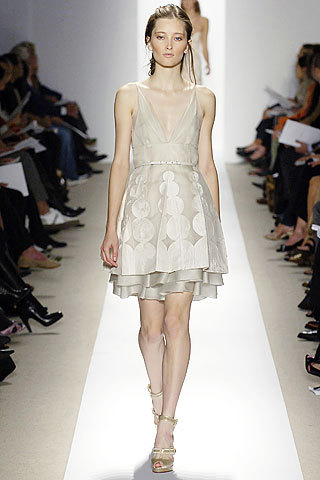
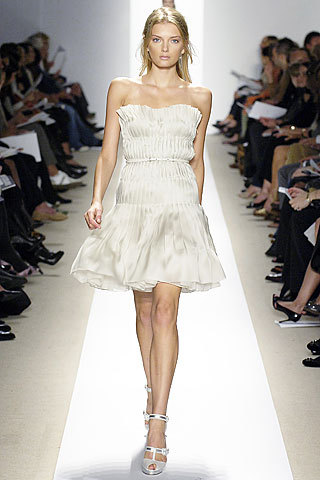 Backstage at the Dsquared show, Chanel Iman, who is part African-American and part Korean, says, "I would love to see different girls from all around the world with different looks and different faces in the shows."
Backstage at the Dsquared show, Chanel Iman, who is part African-American and part Korean, says, "I would love to see different girls from all around the world with different looks and different faces in the shows."
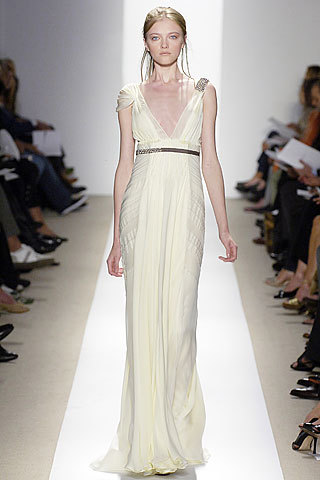 There is also a trend this season to style the models uniformly so they are indistinguishable.
There is also a trend this season to style the models uniformly so they are indistinguishable.
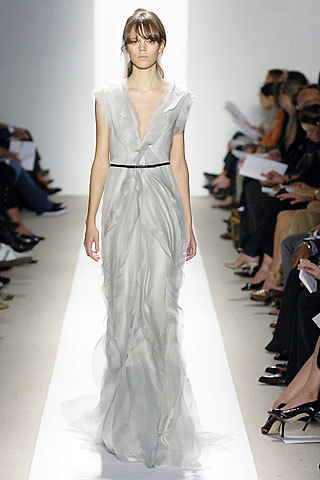 Celia Sears, a
Celia Sears, a 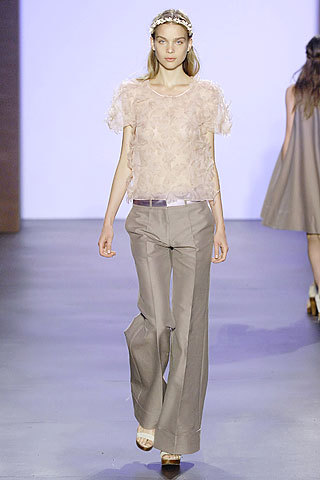 While designers, advertisers and model agencies have generally avoided taking blame for the epidemic of eating disorders connected to body image, the industry will raise the issue Monday, when the Council of Fashion Designers of America holds its first panel discussion at the show on health in the fashion industry.
While designers, advertisers and model agencies have generally avoided taking blame for the epidemic of eating disorders connected to body image, the industry will raise the issue Monday, when the Council of Fashion Designers of America holds its first panel discussion at the show on health in the fashion industry.
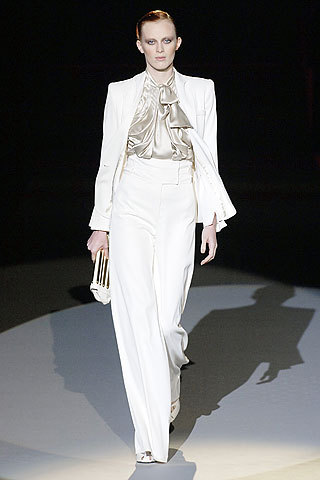 Studies, advertisers at odds
Studies, advertisers at odds
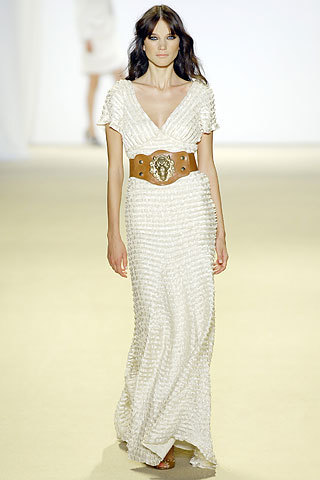 Images more pervasive
Images more pervasive